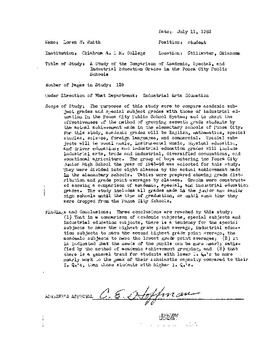| dc.contributor.advisor | Hoffman, C. E. | |
| dc.contributor.author | Smith, Loren Walter | |
| dc.date.accessioned | 2016-06-20T14:35:44Z | |
| dc.date.available | 2016-06-20T14:35:44Z | |
| dc.date.issued | 1952-07 | |
| dc.identifier.uri | https://hdl.handle.net/11244/42194 | |
| dc.description.abstract | Scope of Study: The purposes of this study were to compare academic subject grades and special subject grades with those of industrial education in the Ponca City Public School System; and to check the effectiveness of the method of grouping seventh grade students by the actual achievement made in the elementary schools of Ponca City. For this study, academic grades will be English, mathematics, special studies, science, foreign languages, and commercial. Special subjects will be vocal music, instrumental music, physical education, and driver education; and industrial education grades will include industrial arts, trade and industrial, diversified occupations, and vocational agriculture. The group of boys entering the Ponca City Junior High School the year of 1945-46 was selected for this study. They were divided into eight classes by the actual achievement made in the elementary schools. Tables were prepared showing grade distribution and grade point averages by classes. Graphs were constructed showing a comparison of academic, special, and industrial education grades. The study includes all grades made in the junior and senior high schools until the time of graduation, or until such time they were dropped from the Ponca City Schools. | |
| dc.description.abstract | Findings and Conclusions: Three conclusions are reached by this study: (1) That in a comparison of academic subjects, special subjects and industrial education subjects, there is a tendency for the special subjects to have the highest grade point average, industrial education subjects to have the second highest grade point average, the academic subjects to have the lowest grade point averages; (2) It is indicated that the needs of the pupils can be more nearly satisfied by the method of academic achievement grouping, and (3) that there is a general trend for students with lower I. Q.'s to more nearly work to the peak of their scholastic capacity compared to their I. Q.'s, than those students with higher I. Q.'s. | |
| dc.format | application/pdf | |
| dc.language | en_US | |
| dc.rights | Copyright is held by the author who has granted the Oklahoma State University Library the non-exclusive right to share this material in its institutional repository. Contact Digital Library Services at lib-dls@okstate.edu or 405-744-9161 for the permission policy on the use, reproduction or distribution of this material. | |
| dc.title | Study of the comparison of academic, special, and industrial education grades in the Ponca City Public Schools | |
| dc.contributor.committeeMember | Hunt, DeWitt | |
| osu.filename | Thesis-1952R-L654s.pdf | |
| osu.accesstype | Open Access | |
| dc.type.genre | Master's Report | |
| dc.type.material | Text | |
| thesis.degree.discipline | Industrial Arts Education | |
| thesis.degree.grantor | Oklahoma State University | |
